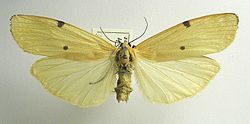| Four-spotted footman | |
|---|---|
 | |
| Mounted female | |
 | |
| Mounted male | |
| Scientific classification | |
| Kingdom: | Animalia |
| Phylum: | Arthropoda |
| Class: | Insecta |
| Order: | Lepidoptera |
| Superfamily: | Noctuoidea |
| Family: | Erebidae |
| Subfamily: | Arctiinae |
| Genus: | Lithosia |
| Species: | L. quadra |
| Binomial name | |
| Lithosia quadra | |
| Synonyms | |
| |
Lithosia quadra, the four-spotted footman, is a moth of the family Erebidae. It is found in southern and central Europe then east across the Palearctic to the Amur River and Japan. It is also found in the south of Great Britain and Scandinavia.
Contents



The wingspan is 35–55 mm. The males are smaller than the females. There is strong sexual dimorphism in the imago, the males have gray wings with a yellow wing joint and a blue-black stripe at the front of the outer rim of the forewing. The females have yellow wings with two blue-black dots. It is the biggest species of the subfamily Lithosiinae.